Fed cuts rates to 3-year low, Gold climbs above $4,200
Posted on — Leave a commentFed Cuts Rates as Dissent Grows Inside the Central Bank
For the third time in 2025, the Federal Reserve slashed interest rates by a quarter point, bringing the benchmark rate down to 3.50-3.75%, a 3-year low. The dissents on the Fed board continues to grow as two members voted to keep rates steady and a third voted to cut rates by a half of a percentage point in a 9-3 vote on Wednesday. 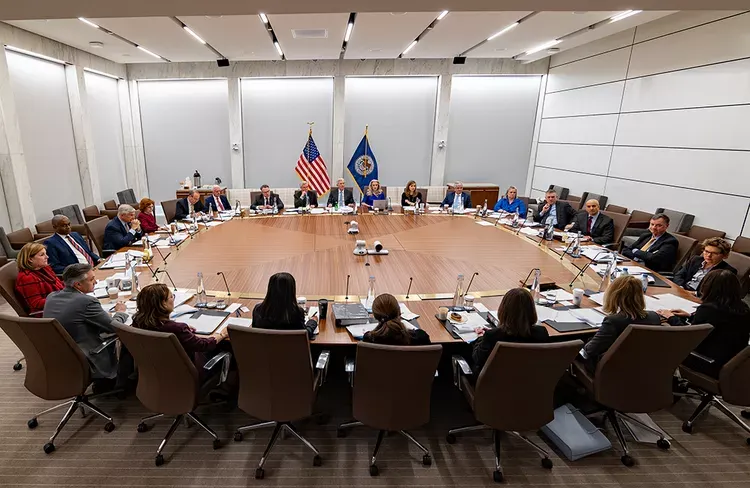
Market Reacts
Gold traded above $4,200 an ounce after the Fed’s decision and silver trades near its new all-time high at $61.31. Stocks gained modestly and Treasury yields declined on the news.
Big picture? The Fed remains between a rock and hard place. Board members made today’s decision despite big blind spots about the state of the economy in the wake of government-shutdown delayed economic reports. And the Fed board is torn between the conflicting forces of stubbornly high inflation and a weakening labor market.
Tough Choices: Jobs and Inflation
The Fed has been trying to walk a tight walk this year. Why? Because interest rate cuts can help strengthen a weakening jobs market, but rate cuts also increase inflation.
Fed Chairman Jerome Powell admitted today in typical Fed-speak understatement that the two goals of the Fed (to promote maximum employment and stable prices) are “a bit in tension.”
Future Rate Cuts Are Cloudy
Looking into the crystal ball for 2026, given the current uncertainty over the actual state of the jobs market and inflation given the delayed government data, Powell also said that he doesn’t think a rate hike is anybody’s base case for the next policy move. The Fed Board’s median projection for 2026 includes just one quarter-point rate cut.
Gold and Silver: Top Performing Assets in 2025
In the midst of the uncertainty, gold and silver stand out as two of the best-performing assets of the year. Gold has chalked up gains of over 60% and silver has nearly doubled in value with a 97% gain. Precious metals are still climbing with new record highs forecast at $5,000 in 2026 for gold and at $65 for silver.
Investors are turning to gold amid a world filled with geopolitical instability, macroeconomic uncertainty, upside risks to inflation, runaway government debt, a weakening U.S. dollar, and concerns that an unsustainable AI-bubble is fueling recent stock market gains.
In the third quarter of this year, Harvard, the world’s largest endowment fund, increased its exposure to gold, totaling over $235 million now. In the midst of rising prices, major institutional investors, hedge funds, high net worth individuals, and everyday Americans are still increasing their allocation to the safety of both gold and silver.
Navigating 2026 Headwinds: Gold and Silver Provide Safety
As we move into a New Year, take the time to explore if your current allocations match your risk tolerance levels. Indeed, today’s risk for investors may be that you are not holding enough precious metals. In a world filled with instability, gold and silver provide the certainty and security of a 5,000-year track record of building wealth. If you’d like a personalized recommendation for your portfolio, Blanchard stands ready to assist. Give us a call today.
ADP Report Reveals Job Losses, Manufacturing Contracts for Ninth Month
Posted on — Leave a commentImagine if you could be a fly on the wall at the next Federal Reserve meeting. From a new round of job losses in November to a lengthy contraction in the U.S. manufacturing sector, when the Fed meets Dec. 9-10, there will be plenty for the Fed governors to talk about.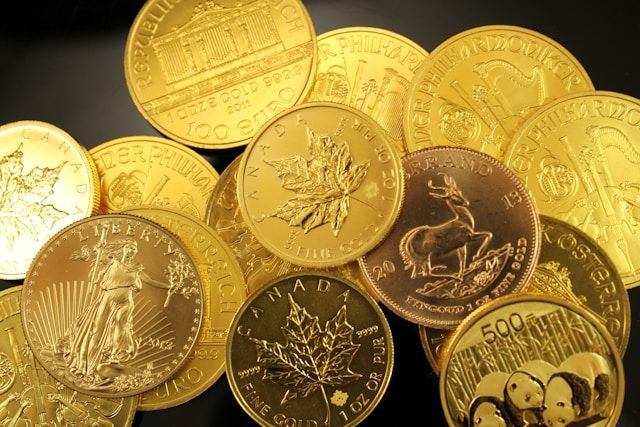
Gold in A Holding Pattern
Since notching a fresh record high in October, gold trade has turned consolidative and sideways as the market takes a breather after its 50%+ gain this year. The long-term uptrend in gold remains intact and these latest signs of renewed economic weakness are positive for the precious metal. Dips toward the $4,000 level have been quickly bought by long-term investors and any weakness in gold is short-lived.
Fresh Look at Labor Market – Small Businesses Lead Decline
In November, private-sector ADP payrolls tumbled by 32,000, while companies with less than 50 employees shed 120,000 jobs—that’s the biggest one-month decline since May 2020. The new ADP report, coming just ahead of the December Fed meeting, shines a spotlight on weakness in the jobs market and gives more ammunition for Fed governors who are pushing for an interest rate cut before the end of the year. Policymakers have been divided on another rate cut given that inflation still remains high and above the Fed’s 2% target rate, but the odds appear to be tipping in favor of a rate cut.
Manufacturing Sector Slows Amid Increased Costs for Materials from Tariffs
Also in November, U.S. manufacturing activity slowed for the ninth consecutive month, according to the Institute for Supply Management. The ISM’s PMI report came in at 48.2, a decline from 48.7 in October. Any reading under 50 is a signal the manufacturing sector is contracting, not expanding. The November contraction was widespread and included the apparel, textiles, paper products, chemicals and transportation equipment industries. Manufacturers point to tariffs as the main factor causing the contraction. In many cases, it now more expensive for U.S. producers to source materials from abroad that are needed in their manufacturing processes. The ISM survey also found that manufacturers were holding back on hiring as they tried to manage the higher production input costs and slowdown in orders.
What It Means for Gold
Gold prices jumped following the news of the ADP jobs losses as it boosted expectations the Fed will cut rates at its December meeting. Lower rates are positive for non-interest bearing precious metals. Meanwhile, weakness in the manufacturing sector supports demand for gold as a safe-haven asset. Spot gold is trading just above $4,200 an ounce with bullish momentum growing. Prices are likely to remain range-bound into the Fed meeting, and a breakout above $4,373.20 would signal gold is extending into a new bullish phase, with a target at $5,000 in 2026.
Quiet markets like we are seeing today are ideal for orderly accumulation and fractional gold like 1/10 ounce American Gold Eagles, priced at $499.80 (market prices fluctuate) offer the same level of future upside as a 1 ounce gold coin. Act today with an increased allocation to physical gold and watch your wealth grow in all the tomorrows that follow.
The Story Behind the 1936-S Bay Bridge Silver Half Dollar
Posted on — Leave a commentThe 1936-S Bay Bridge Silver Half Dollar is one of the most beloved classic commemoratives in U.S. coinage. With its bold design, regional pride, and limited production, it captures a moment in California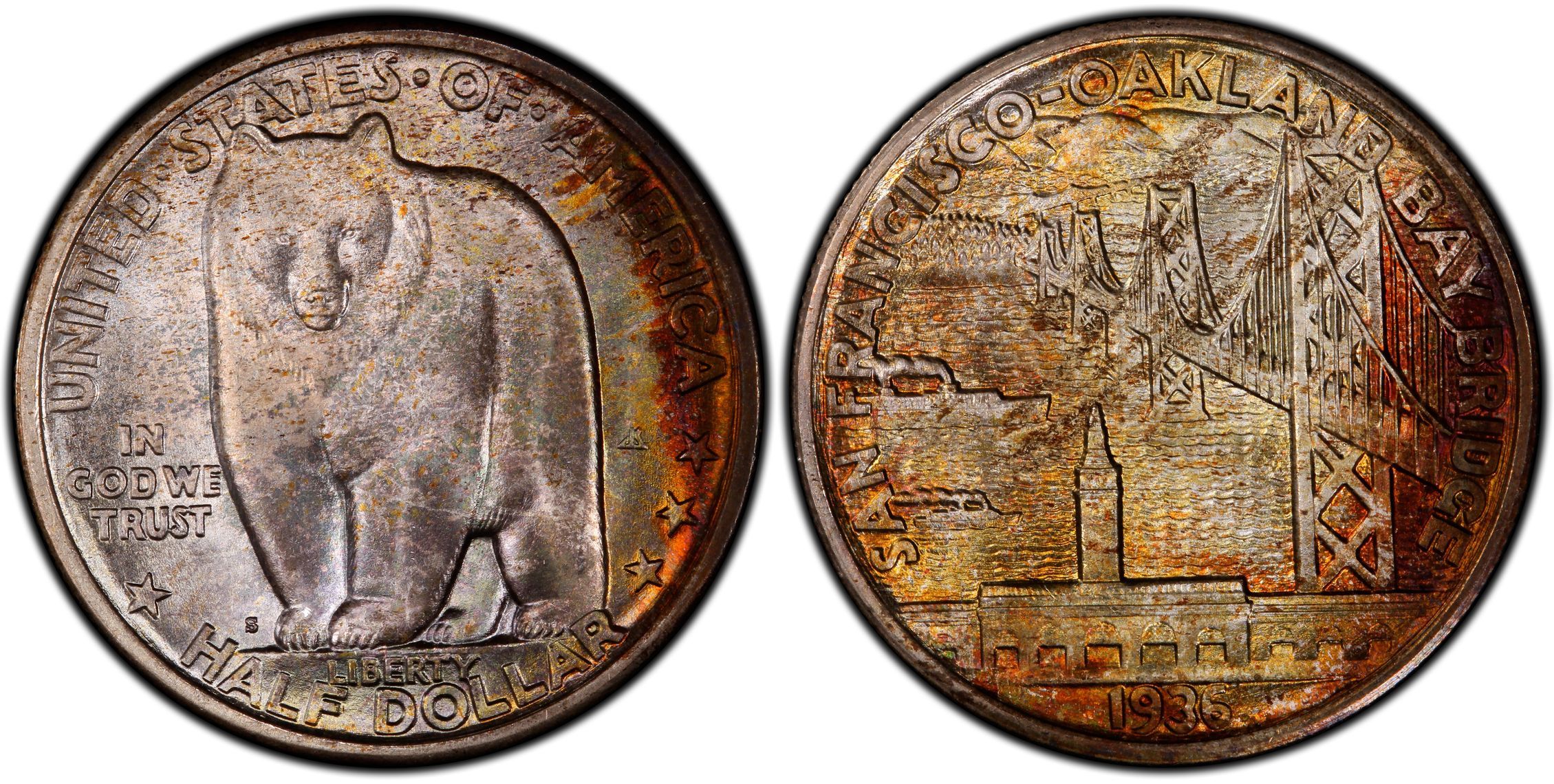 history when the West was rising in national importance. More than just a collectible coin, it is a silver time capsule that celebrates one of the greatest engineering achievements of its age: the San Francisco–Oakland Bay Bridge. This is the story of how it came to be, why it became such a standout in the commemorative series, and what continues to draw collectors to it today.
history when the West was rising in national importance. More than just a collectible coin, it is a silver time capsule that celebrates one of the greatest engineering achievements of its age: the San Francisco–Oakland Bay Bridge. This is the story of how it came to be, why it became such a standout in the commemorative series, and what continues to draw collectors to it today.
Honoring a Modern Marvel
The early to mid-1930s saw a wave of commemorative coin programs, many tied to local celebrations and anniversaries. The completion of the Bay Bridge in 1936 was a perfect candidate for a coin issue. It had taken more than three years of round-the-clock labor to complete the massive structure connecting San Francisco and Oakland. At the time of its opening, it was one of the longest steel bridges in the world and a visible symbol of American optimism during the Great Depression.
To mark this achievement, Congress authorized a commemorative half dollar to be struck at the San Francisco Mint. The coins would be sold to the public at a small premium, with proceeds supporting civic celebrations around the new bridge. The result was the 1936-S Bay Bridge Silver Half Dollar, a coin as bold and striking as the bridge itself.
A Design That Captured the Spirit of California
One reason the Bay Bridge Half Dollar remains so popular is its stunning artwork. The designer, Jacques Schnier, was a San Francisco sculptor known for his modern style. He delivered a design that felt fresh and forward-leaning, breaking from the more classical motifs that had dominated commemorative coinage.
The obverse features a powerful California grizzly bear, standing tall with a quiet sense of strength. This was not simply a regional mascot. The bear symbolized resilience, independence, and the rugged identity of California. Collectors have long admired the depth, texture, and visual weight Schnier brought to the image.
The reverse is a beautifully balanced view of the Bay Bridge stretching across the bay, with Yerba Buena Island and the San Francisco skyline rising in the background. The architectural detail is crisp, and the scene conveys the blend of artistry and engineering that defined the era. Few commemorative coins of the 1930s feel as modern or as cleanly executed as this one.
Mintage, Distribution, and Collector Appeal
The 1936-S Bay Bridge Half Dollar was struck exclusively at the San Francisco Mint, with a mintage of 100,000 coins for distribution. Another 2,000 pieces were produced for assay purposes. While most sold quickly through local committees and distributors, a portion went unsold and were returned to the Mint for melting.
This combination of limited mintage, strong regional interest, and exceptional design gave the coin a strong foothold in the commemorative market. Unlike some other 1930s issues that struggled to find an audience, the Bay Bridge Half Dollar maintained steady demand. Today, collectors appreciate its bright luster, the bold bear motif, and the artistry of its engraving. High-grade examples, especially those with strong mint luster and clean surfaces, remain particularly desirable.
A Legacy That Endures
The Bay Bridge Silver Half Dollar stands as a testament to a defining moment in California history. It honors a landmark that reshaped the region’s transportation and economy. It showcases one of the most memorable bear designs in American numismatics. And it represents the spirit of innovation that marked the 1930s United States, even during challenging economic times.
For modern collectors, the 1936-S Bay Bridge Half Dollar offers the chance to hold a piece of that history in hand. It is a classic commemorative that continues to shine, bridging the past with the present and reminding us of the bold ambitions that helped shape the American West.
Retail Sales, ADP Report, Confidence Survey Reveals Economy Remains Sluggish
Posted on — Leave a commentGold climbed and stocks slumped as private ADP jobs report revealed accelerating job losses, a confidence survey showed a downturn in sentiment and new retail sales data disappointed. Gold hit a 10-day high following the news and stocks turned lower.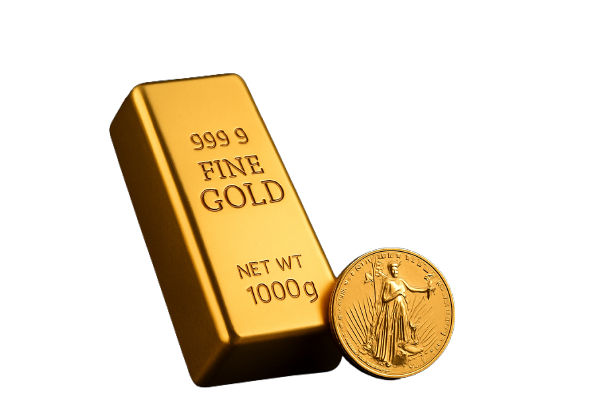
Digging Deeper into the Economic Outlook
Payroll processing firm ADP reported that job losses averaged 13,500 per week for the four weeks ending November 8, which pushed stocks lower as “risk-off” trading sentiment increased. The ADP report reveals bigger questions about how weak the U.S. labor market truly is.
Wall Street economists remain in catch up mode following the government shutdown on Oct. 1 that lasted to mid-November. Government statistics agencies are still compiling reports from several months ago, leaving investors and economists with an incomplete picture on the economy today.
Consumer Spending Grows, But Less Than Expected
Retail sales rose by 0.2% in September, the Commerce Department said. That fell short of Wall Street’s forecasts for a 0.3% rise. Americans pulled back on purchases in a number of categories that were affected by tariffs, including cars, electronics and clothing.
Also, the Conference Board just released its latest consumer confidence survey for November, which fell to 88.7 from 95.5 in October, again below consensus expectations for a 93.2 reading.
Another shutdown delayed report revealed that the producer price index showed goods and services moved higher in September. PPI rose 0.3% in September, following a 0.1% increase in August.
Putting It All Together
All in all, the new economic data reveals that heading into the holiday season, Americans see a job market losing steam, still-rising inflation, and falling consumer confidence, which is leading some people to rein in their spending.
Gold Is Rangebound in Pre-Holiday Trade
Since touching a record high above $4,300 an ounce in October, gold trade has turned consolidative and sideways. For the past two months, gold has traded in range between roughly $4,200 on the upside and $4,020/$4,000 on the downside. Dips have been short-lived as buyers entered the market to accumulate gold under the $4,020 level.
The long-term trend for gold points higher and the major fundamental drivers for uptrend remain intact. Central banks remain large buyers of physical gold, investors and funds are diversifying into precious metals to hedge against rising government debt levels, falling U.S. dollar values, still-high inflation and to protect portfolios against stock market volatility. Major Wall Street firms project a fresh climb to a new record high at $5,000 in 2026.
The Importance of Managing Risk In Your Portfolio
Given today’s heightened macroeconomic uncertainty, it’s time to consider an increase in allocation to physical gold and silver as a core portfolio risk-management tool. A higher strategic allocation to precious metals can help you preserve purchasing power, reduce portfolio volatility, and act as a vehicle to grow your wealth even when assets like stocks and bonds fall.
Beyond wealth preservation, the investment case for gold and silver extends to proven portfolio diversification benefits. Physical metals consistently deliver low correlation to major paper asset classes such as stocks and bonds. During market drawdowns triggered by geopolitical disruptions or stock market declines, gold in particular has historically demonstrated positive performance. Silver, with its hybrid industrial and monetary characteristics, offers both a defensive hedge and exposure to long-term manufacturing trends in renewable energy and electronics.
How to Safely Add Precious Metals to Your Portfolio
Consider increasing your allocation to gold and silver with physical bars and coins held with reputable custodians or in direct personal custody, rather than unbacked or highly leveraged paper substitutes.
How large should your precious metals allocation be? We can help tailor a position size appropriate for your personalized liquidity needs, risk tolerance, and existing exposure to real assets. If you have questions on how to best position your portfolio for safety and growth, please call Blanchard today. We stand ready to assist you in these uncertain times.
Jobs Data Puts December Rate Cut in Question: Gold Trades In Holding Pattern
Posted on — Leave a commentThe September jobs report, which arrived seven weeks late, due to the U.S. government shutdown revealed that 119,000 new jobs were created that month. That far outpaced expectations for a 50,000 job gain. The better-than-expected September jobs report called into question whether or not the Federal Reserve will pull the trigger on a third interest rate cut when it meets in December.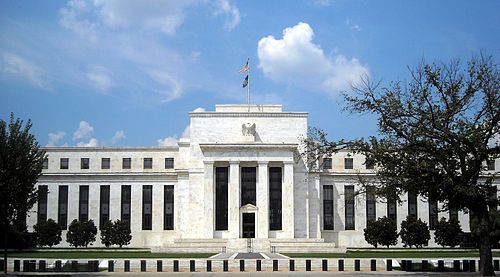
U.S. stocks initially gained on the news, but quickly reversed lower and wiped out earlier gains as concerns about an AI bubble continue to press equities lower. Gold largely traded sideways and is consolidating in a sideways holding pattern between $4,000 and $4,212 an ounce.
The long-term trend for gold points higher and the precious metal has gained over 50% since the start of the year. The neutral sideways phase is a temporary holding pattern as the metal takes a much needed breather.
While the fresh jobs data is a look in the economy’s rearview mirror back to September, it is the last major piece of labor market data the Fed officials will see before they meet next on December 9-10.
The stronger than expected payrolls number could provide cover for those Fed officials who want to take a break from easing and hold interest rates steady at the December gathering. However, Fed officials appear deeply divided over the path of monetary policy, according to the minutes from the latest meeting.
“In discussing the near-term course of monetary policy, participants expressed strongly differing views about what policy decision would most likely be appropriate at the Committee’s December meeting,” the minutes read.
What does this mean for gold? What does this mean for stocks?
Gold benefits from Fed interest rate cuts, so a pause in the Fed’s recent rate cuts would be a neutral signal for the precious metal. For stocks, it is a different picture. The stock market has in part been climbing amid expectations of a series of rate cuts this year and if the Fed fails to deliver, it will create additional downside momentum for an already fragile stock market.
For investors this is a pivotal moment.
The stock market is getting hammered as the S&P 500 sank below its 50-day moving average for the first time in 138 days. As stocks slid lower, bitcoin also fell sharply trading below $87,000. All in all, it was an ugly day on Wall Street for stock investors following the jobs report and the near-term trend for stocks points down. The stock market may well be on the precipice of a larger and sustained collapse that has been months in the making driven by a few large-cap technology stocks.
Now’s your chance to take action to protect your portfolio.
If you’ve been sitting on the sidelines, take a look at your portfolio today. We’ve seen many investors rebalancing their portfolios in recent weeks, cashing in on overstretched stock positions and funneling those assets into the safety of gold and silver.
Wall Street traders like to say: stocks take the stairs higher and the elevator down. Use today’s sideways consolidation in gold to increase your exposure to precious metals. With forecasts at $5,000 for gold in 2026–the gold trade is a one-way trade higher. Over the next few weeks or months, stocks could be a one-way trade lower.
When stocks crash, precious metals climb. Take advantage of this brief moment in time before the stock market is down 20% or 30% and make your portfolio shift today. Do you have questions or want to talk through what investment moves are best for you and your unique financial situation? Blanchard stands ready to assist–call us today!
The Story Behind the 1851 $50 Humbert 880 Reeded Edge
Posted on — Leave a commentFew coins capture the raw urgency, ambition, and chaos of the American Gold Rush the way the 1851 $50 Humbert 880 Reeded Edge does. Today, this octagonal “fifty-dollar slug” stands among the most legendary issues in American numismatics, but its story begins in the dusty, makeshift streets of early San Francisco—where gold was plentiful, coinage was scarce, and commerce was held together with luck, grit, and a handshake.
early San Francisco—where gold was plentiful, coinage was scarce, and commerce was held together with luck, grit, and a handshake.
The California Gold Rush and a Desperate Need for Coinage
When waves of prospectors began pouring into California in 1848 and 1849, they brought a hunger for wealth but very little in the way of practical currency. Gold dust was everywhere, but federal mint strikes were thousands of miles away. Business owners quickly discovered that gold dust was nearly impossible to standardize. One man’s teaspoon of dust never quite matched another’s. Even when weighed, purity varied wildly.
Merchants needed something stable—something trustworthy—to conduct daily commerce. That gap between chaotic gold dust and trustworthy hard money created a unique opportunity, and one man in particular stepped forward to meet it: Augustus Humbert.
Augustus Humbert and the U.S. Assay Office in San Francisco
Augustus Humbert was a New York watchmaker who gained a reputation for precision and integrity. His skill earned the attention of federal officials in Washington, and in 1851 he was appointed United States Assayer for California. The newly established U.S. Assay Office in San Francisco opened its doors with a single purpose—convert raw California gold into a reliable, federally sanctioned medium of exchange.
Enter the massive, unmistakable gold “slugs.” These fifty-dollar pieces were unlike anything the official U.S. Mint had ever produced. Octagonal in shape, stamped with Humbert’s name and the weight and fineness of their gold, they were large enough to be noticed across a saloon and heavy enough to anchor a ledger. The most famous of these is the 1851 $50 Humbert 880 Reeded Edge.
The 880 Thous. Fineness and the Reeded Edge
The inscription “880 THOUS.” refers to the coin’s 88 percent gold purity—slightly lower than the later standard of .900 but consistent with the natural composition of much California placer gold. What made these slugs invaluable was not a perfect fineness standard but consistency. An 880-fine Humbert piece carried the same trust as a banknote in the East. Business owners accepted them readily because they finally had a unit of value that was predictable and federally approved.
The Reeded Edge variety, in particular, represents a transitional and historically fascinating moment. While many Humbert slugs bore a lettered edge, the reeded version signaled a push toward more standardized production. Reeded edges were harder to tamper with and showed a more refined level of craftsmanship—an early hint that California coinage was inching its way toward formal U.S. Mint operations.
A Coin Born of Necessity—and Carried Through Adventure
Holding an 1851 Humbert slug today feels like holding a piece of frontier life. These coins traveled in saddlebags, strongboxes, coat pockets, and bank vaults across the West. Miners bought tools with them. Merchants used them to settle large accounts. Some were carried through treacherous overland journeys. Others sat behind saloon bars as payment for debts men promised to settle “come spring.”
One of the great ironies is that despite their massive size and weight—over two and a half ounces—these coins circulated actively. In a world where every gold shipment risked robbery, storm, or loss at sea, a large denomination piece was practical. A man could settle a major transaction without carrying a bag of dust or a pouch of smaller coins.
The Decline of the Humbert Slug
When the San Francisco Mint opened in 1854, the era of private and semi-official Gold Rush coinage began to fade. Standardized federal coinage replaced Humbert’s hefty slugs, and over time many were melted for their gold. Survivors became numismatic treasures, their history preserved not by circulation but by collectors who recognized their significance.
Today, the 1851 $50 Humbert 880 Reeded Edge is a centerpiece rarity—admired for its size, its artistry, and its unmistakable place in American history. It represents a moment when California needed money fast, and one man’s precision and leadership helped stabilize an entire regional economy.
Why Collectors Still Pursue This Icon
For numismatists, the 1851 Humbert slug offers a blend of rarity, origin story, and sheer presence. Its octagonal shape, bold inscriptions, and official U.S. Assay Office pedigree make it one of the most visually compelling coins ever produced on American soil. Combined with low survival rates and strong demand among Gold Rush collectors, it stands as a bucket-list piece—whether found in high grade or in a well-worn example that clearly lived a full life on the western frontier.
Final Thoughts
The 1851 $50 Humbert 880 Reeded Edge is more than a coin. It is a relic of human ambition—the kind that sends people into mountains, rivers, and unknown territory chasing the promise of a better life. It is a reminder of how quickly a nation can grow, improvise, and adapt. And for collectors today, it remains one of the most compelling artifacts of the American West ever struck in gold.
Four Countries Dominate Investment Demand for Silver Bars and Coins
Posted on — Leave a comment2025 has been a bellwether year for precious metals and not just gold. As investors around the world turn to the safety of precious metals, demand for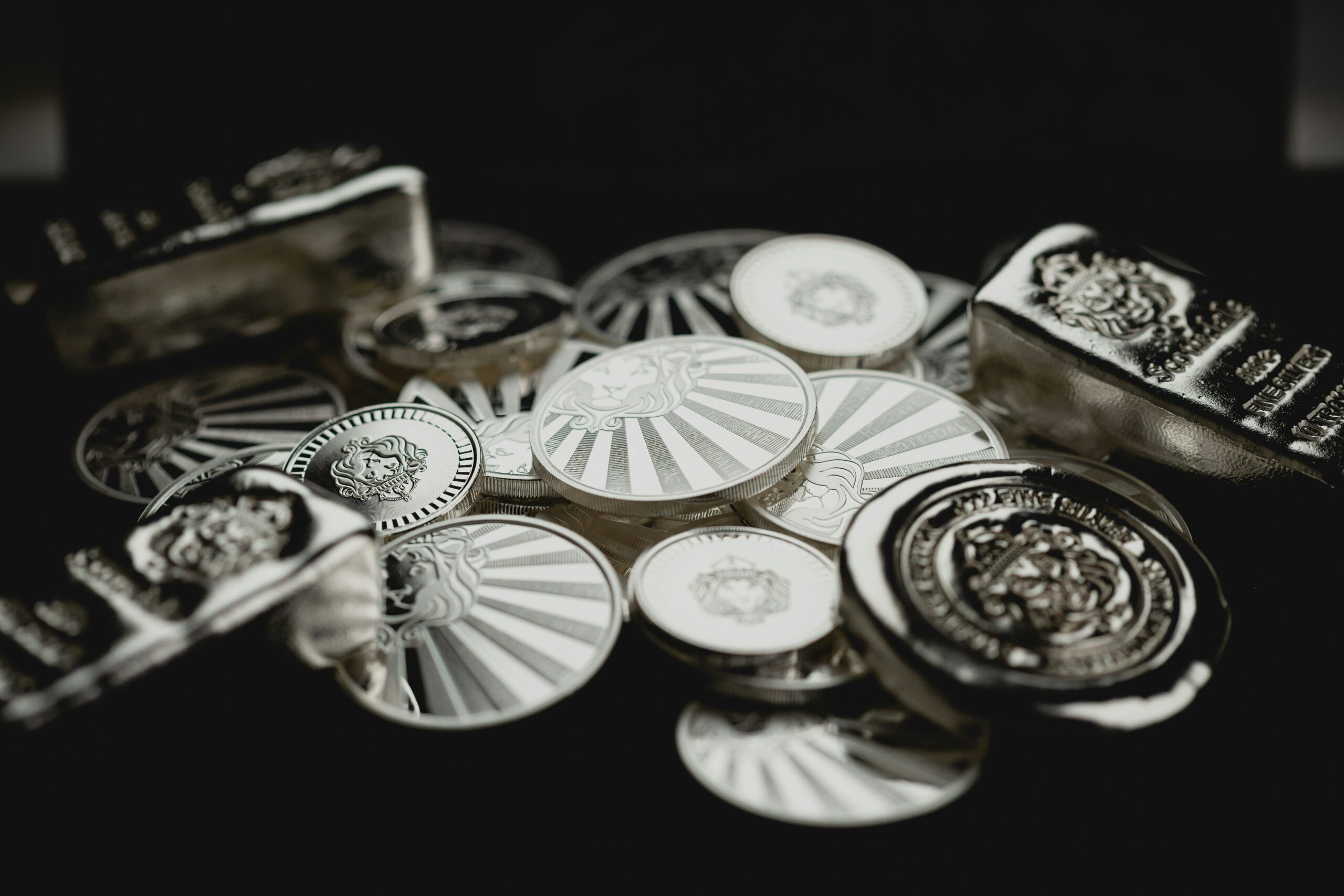 silver bars and coins has shot sharply higher. Notably, investment demand from the United States, India, Germany, and Australia accounts for nearly 80% of global demand for silver bars and coins, according to a new report from precious metals consultancy Metals Focus.
silver bars and coins has shot sharply higher. Notably, investment demand from the United States, India, Germany, and Australia accounts for nearly 80% of global demand for silver bars and coins, according to a new report from precious metals consultancy Metals Focus.
Why are investors turning to silver bullion?
Rising government debt, heightened global political tensions and historical evidence that shows silver is undervalued compared to gold has increased investor appetite for silver in 2025.
This year’s silver gains have been eye-catching. Spot silver hit a new record high at $54.56 an ounce in October and has soared 65% since the start of 2025. Record gold prices have also boosted silver’s appeal as the white metal delivers many of the same safe-haven properties, but at a less expensive price point.
Wondering what lies ahead? Silver is rising in a long-term historic uptrend, and the metal is still climbing.
In October, Bank of America raised its 2026 silver forecast to $65. This year, the global silver supply forecast is expected to come up short for the fifth year in a row. Big picture, a persistent supply/demand imbalance, driven by strong investment and industrial demand keeps Wall Street focused on higher levels for silver in the years ahead.
Digging deeper into the four major countries driving gold demand, investors in the United States lead the pack, according to the Silver Institute.
United States: The scale of U.S. buying has been astounding, with a combined total of 1.5 billion ounces (Boz) of silver purchased by retail investors between 2010 and 2024.
India: India is the second-largest physical silver investment market in the world, but has occasionally eclipsed the U.S. There is a long-standing tradition for India’s citizens to own physical silver, typically in the form of silver bars, which in 2024 comprised 70% of total retail demand.
Germany: Germany has long held stood as the world’s third-largest market for silver bar and coin investment. Germans have a particular affinity to own silver bullion coins, which accounts for roughly 80% of total silver demand there.
Australia: In recent years Australia emerged as the world’s fourth-largest physical silver market. While in 2019, Australian silver coin and bar demand stood at just under 3.5 million ounces, by 2022, that number surged to a record high of 20.7 Moz.
Precious metals investors have witnessed a historic run in 2025. The uptrend is still strong and the factors which created robust demand for gold and silver remain in place. Looking into 2026, forecasts stand at $5,000 for gold and $65 for silver. For many precious metals investors today, the question is not when to get into the market, but how much should you buy?
No matter whether you prefer silver bars or silver coins, Blanchard has a large selection of bullion inventory available to ship today. Explore your options. If you are unsure about how much gold or silver is optimal for your portfolio, call Blanchard today. We stand ready to assist.
The Story Behind the 1870 $3 Gold Coin: A Rarity with a Golden Legacy
Posted on — Leave a commentIntroduction
Every so often, a coin comes along that feels more like a secret than a piece of currency. The 1870 $3 Gold Coin is one of those secrets, a golden whisper from a bygone era when America was expanding westward,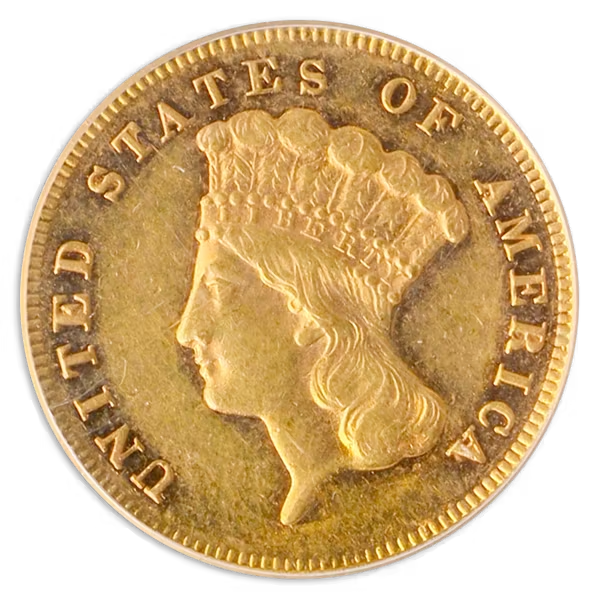 railroads were weaving the nation together, and gold was still king. Today, it stands as one of the most fascinating survivors of 19th-century U.S. Mint history.
railroads were weaving the nation together, and gold was still king. Today, it stands as one of the most fascinating survivors of 19th-century U.S. Mint history.
Though its face value seems modest by modern standards, the $3 gold piece represents a short-lived experiment in monetary innovation and a window into the ambitions of a young, growing nation.
The Origin of the $3 Gold Coin
The $3 gold denomination was born out of practicality, or at least, that was the idea. In 1853, Congress authorized the coin, largely to simplify the purchase of postage stamps. At the time, a sheet of 100 three-cent stamps cost exactly three dollars, so the $3 coin seemed like a convenient way to pay.
First struck in 1854, the coin was designed by Chief Engraver James Barton Longacre, the same artist behind the Indian Head cent. His $3 design features Lady Liberty wearing a feathered headdress, a distinctive nod to both classical beauty and Native American symbolism. On the reverse, a wreath of corn, wheat, cotton, and tobacco represented the country’s agricultural strength.
Unfortunately, practicality didn’t translate into popularity. Americans simply didn’t need a $3 coin in everyday commerce. Most transactions were handled in $1 or $2 increments, and the coin never circulated widely.
1870: A Year of Low Mintages and Lasting Mystique
By the time 1870 arrived, the $3 gold coin was already fading from daily use. The California Gold Rush had waned, the Mint was refining its production levels, and the nation’s monetary focus was shifting. Still, that year would produce one of the most intriguing issues in the entire $3 gold series.
The Philadelphia Mint struck only 3,500 circulation coins in 1870, while branch mints such as San Francisco produced even fewer. The 1870-S $3 gold coin, in fact, is one of the greatest rarities in all of American numismatics—believed to have only one known surviving specimen. It was likely struck for inclusion in the cornerstone of the new San Francisco Mint building, making it both legendary and nearly unattainable.
For collectors, the 1870 issue carries a dual allure: the relative scarcity of the Philadelphia strikes and the near-mythical status of the 1870-S. Even circulated examples from the Philadelphia Mint are prized, while the lone San Francisco specimen exists in a class of its own.
The Design Details That Endure
What makes the 1870 issue particularly appealing is the purity of its design. Lady Liberty’s profile is surrounded by the inscription “UNITED STATES OF AMERICA,” her hair crowned with a stylized headdress that merges Greco-Roman ideals with an American frontier spirit. It is both regal and humble, a blend that captures the optimism of the post-Civil War era.
The reverse design is equally poetic. The agricultural wreath encircling the denomination “3 DOLLARS” is a quiet tribute to the nation’s self-reliance and abundance. Every detail, from the fine engraving of the leaves to the balanced layout of the lettering, showcases Longacre’s artistry.
Each 1870 $3 gold coin was struck in .900 fine gold, weighing 5.015 grams with a diameter of 20.5 millimeters, roughly the size of a modern nickel but with a far greater story to tell.
Why Collectors Treasure the 1870 Issue
The allure of the 1870 $3 Gold Coin goes beyond its low mintage. It represents a turning point in U.S. Mint history—a time when experimentation and artistry still guided coinage design. Its rarity, beauty, and connection to one of America’s most mysterious minting stories make it a centerpiece for any advanced collection.
For collectors today, owning one is a connection to a moment when the U.S. Mint was pushing boundaries, when every engraving carried symbolic meaning, and when gold coins embodied trust and value. Its scarcity ensures it will always stand apart, a tangible piece of numismatic history that feels as personal as it does historical.
The Legacy of a Forgotten Denomination
The $3 gold piece was officially discontinued in 1889, closing a 35-year chapter of American coinage. Yet its legacy endures through pieces like the 1870 issue, coins that speak of ambition, artistry, and a restless pursuit of perfection.
For modern collectors, this coin is not just about rarity. It is about storytelling, a story told in gold, shaped by the hands of history, and preserved by generations who recognize that beauty often hides in the most unexpected corners of the past.
Are you looking for something special for your collection? For over fifty years, Blanchard has been the premier authority on high-end numismatic treasures. Give us a call today and let us help you find exactly what you’re looking for.
Global Gold Demand Rose 3% in 3Q, As Money Supply Hits New Record
Posted on — Leave a commentGold demand just hit a new record high for the third quarter at 1,313 metric tons, the highest quarterly number on record, the World Gold Council said. Demand for gold is rising just as the U.S. paper money supply reaches a new record high.
Total investment demand for gold climbed 47%, demand for gold bars and coins surged 17% totaling 315.5 tons, and central bank buying jumped 10% to 219.9 tons in the third quarter.
So, who’s buying up all this gold?
It turns out it’s a mix of investors—from central banks beefing up their reserves to institutional investors looking to protect their portfolios, and everyday Americans buying gold as a haven against rising inflation, currency devaluation, and concerns over rising government debt levels.
Gold is the safest money
Ray Dalio, billionaire investor and founder of Bridgewater Associates, shared an essay on Oct. 30 called “Gold is the Safest Money.” Dalio believes that gold is the “most fundamental money over time, with the best track record of having its value track the cost of living over very long periods of time.”
Dalio points to the way currencies are structured as the key reason that gold has stood the test of time and remains the safest form of money.
Throughout history, currencies have either been “hard-backed” currencies or “fiat” currencies. Hard-backed currencies have been historically connected to physical gold or to something similarly limited in supply and globally valued, like silver.
People with hard-backed currencies could exchange their paper money for physical gold or silver at a fixed exchange rate. That compares to fiat currencies, which aren’t backed by anything and aren’t limited in supply.
The U.S. dollar is a fiat currency.
Today, the U.S. government debt continues to barrel higher, recently climbing above $38 trillion—a record high in October 2025, and at the same time our fiat money supply is expanding.
What’s the connection between fiat currencies and government debt?
Dalio studied past fiat currency systems when there was too much debt relative to the amount of money that was needed to pay it. Just like what we are seeing in America today.
To combat the rising debt levels, central bankers created a lot of money and credit, which typically led to higher inflation and higher gold prices. This is what we are seeing today as well.
U.S. money supply hits record high: easy money is back
Money supply accelerated in 2025 and recently hit a record high above $22.2 trillion, as shown in the chart by the St. Louis Federal Reserve. Money supply refers to the total amount in circulation, including coins, cash, and bank-account balances.
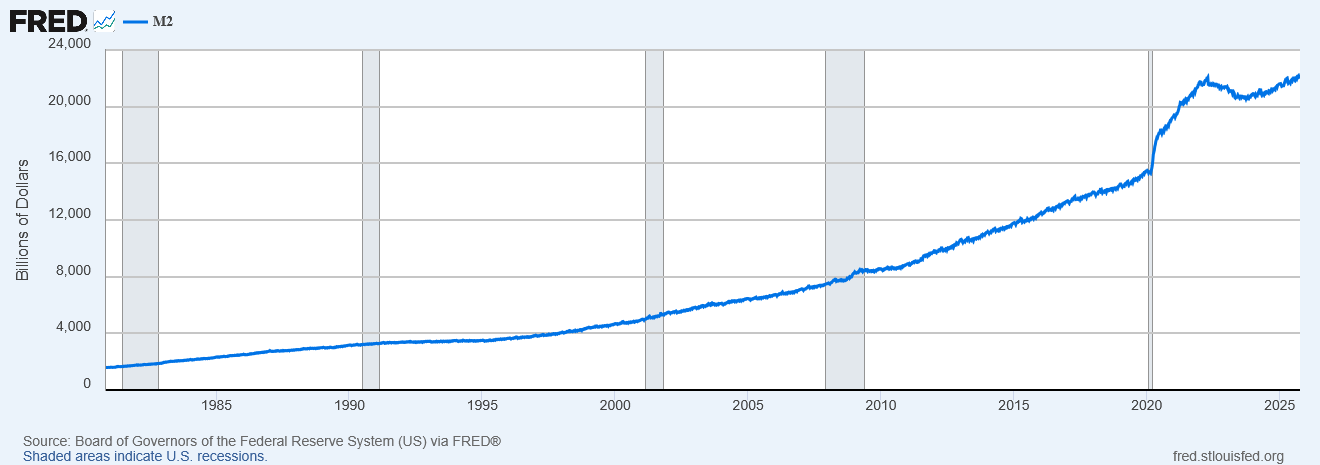
Gold holds Its purchasing power
As central banks create more fiat currency, it loses value.
Dalio found that throughout history when governments with fiat currencies took on unsustainable debt levels, gold performed well. In fact, he found that over long periods of time, gold was the money with the best track record of holding its purchasing power. This is why it is now the second-largest reserve currency held by central banks today.
Gold trend still points higher
As central banks buy more physical gold to add to their reserves and the U.S. government prints more money and expands our fiat money supply, where does true value lie? Dalio says gold. This is just one of the many reasons investors are turning to gold to preserve and protect their wealth and purchasing power today.
Investors are buying heavily this year as the strong uptrend for gold continues. Spot gold is up over 50% this year, after hitting a record high at $4,373.20 on Oct. 16. You may be asking, can this rally in gold continue? Most say yes.
“The outlook for gold remains optimistic, as continued U.S. dollar weakness, lower interest rate expectations, and the threat of stagflation could further propel investment demand,” said Louise Street, senior markets analyst at the World Gold Council. “Our research indicates the market is not yet saturated.”
As government debt levels rise, fiat currency expands, and inflation increases—the value of your U.S. dollar is falling. Gold is a currency with a 5,000-year track record. The time is ripe to trade some of your paper dollars that are decreasing in value for gold. Throughout history gold has proven to be the safest money of all. Do you own enough?
Chinese Coins: From Ancient Cash to Modern Silver Pandas – Your Complete Collector’s Guide
Posted on — Leave a commentChinese coins present one of numismatics’ most rewarding categories – and one of its most challenging. Spanning more than two millennia, it ranges from cast bronze cash coins and imperial silver issues to modern Panda bullion that rivals Western standards. For collectors, this depth offers genuine opportunity but also significant obstacles: unfamiliar scripts, overlapping reign marks, and a market where counterfeits exist for virtually every major issue. This guide outlines the major eras of Chinese coinage, the factors that influence value, and practical considerations for building a serious, well-curated collection.
What Makes Chinese Coins Special
Before exploring individual eras and coin types, it helps to understand what defines Chinese coinage as a whole.
Enduring Continuity
When the Qin Dynasty unified China in 221 BC, it standardized currency into a form that would outlast the Roman Empire, the Byzantine solidus, and medieval European coinage combined. Chinese coins with a square hole in the middle became China’s monetary standard and remained essentially unchanged until the Qing Dynasty fell in 1912, a span of over two millennia. While European coinage fragmented into regional types and underwent constant reforms, Chinese cash coins preserved their design through dozens of dynastic transitions. This continuity created a visual identity that transcends individual reigns.

Image: Qing Dynasty cash coin with square hole and Chinese characters.
Source: Museums Victoria
Symbolism and Authority
Rather than portraits, Chinese coins displayed reign marks, i.e. characters proclaiming the emperor’s era name. This creates a fundamentally different collecting challenge than Western coinage. Instead of identifying rulers by profile, collectors must learn Chinese scripts and recognize calligraphic styles that varied by dynasty. Later issues added dragons, phoenixes, and clouds, connecting currency to celestial legitimacy.
Calligraphy and Craftsmanship
The inscriptions on Chinese coins weren’t struck from identical dies like Western issues. Most were cast from molds, meaning calligraphy was carved directly into the master model by hand. Each dynasty developed its own script style, and individual mints often interpreted these characters differently. A Northern Song coin might show fine, balanced strokes reminiscent of brush calligraphy, while Qing issues favor heavier, more regular forms. For collectors, this variation gives each specimen individuality.
Modern Continuity: The Panda and Beyond
Modern bullion issues like the Gold and Silver Panda series, introduced in the early 1980s, carry forward these principles in contemporary form. The changing panda designs echo the artistic individuality once expressed through calligraphy, while inscriptions in standardized Chinese script preserve the link between currency and national identity. Struck to precise international standards, Pandas merge ancient symbolism with modern minting technology – proof that Chinese coinage still balances tradition, innovation, and artistry in the global bullion market.
Complete Chinese Coin Era Breakdown
Chinese coinage is divided into ancient cast issues and modern struck coins.
Ancient Chinese Coins: Cash Coins and Imperial Issues
Origins of Chinese Money (Pre-221 BC) [H4]
Before standardized coinage, Chinese states used cowrie shells, spade money (flat bronze pieces shaped like agricultural tools), and knife money (bronze knife-shaped currency from northern regions). These early forms carried inscriptions identifying issuing authorities. Authenticating them requires examining weight consistency, natural patina, and casting quality. Reproductions typically show artificial aging and anachronistic or poorly executed inscriptions. For a visual guide to some of the most valuable early Chinese coins and their distinguishing features, watch this video.
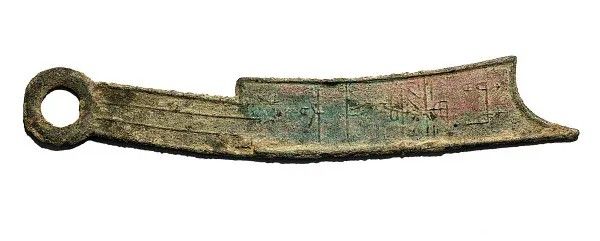
Image: Ancient Chinese bronze knife money with inscriptions.
Source: National Museum of American History
The Qin Reform and Birth of Cash Coins (221 BC)
Emperor Qin Shi Huang standardized currency into the ban liang, i.e. a round bronze coin with a square hole, eliminating regional varieties and establishing the format that would last two thousand years.
Dynastic Evolution of Cash Coins (Han – Qing)
Cash coins maintained their basic form across dynasties but evolved in inscription style, weight, and casting quality. Most display four-character legends read top-bottom-right-left, naming the reign era and denomination. Calligraphic styles varied: Han coins show simple characters, Tang pieces display elegance, Song issues feature refined execution, and Qing coins use bolder scripts. Provincial mints created subtle variations useful for attribution. In terms of availability, late Qing and Ming issues remain common, but certain early Han types and well-preserved Song specimens command significant premiums. Condition plays a major role in valuation, with collectors prioritizing crisp characters and natural patina over worn or corroded examples.
Imperial Silver and Gold (Late Qing – 1911)
As Western powers pressured China to modernize its currency, the Qing government introduced machine-struck silver coins in 1889. These pieces were Chinese coins with dragon designs featuring bilingual Chinese and Manchu legends, created to compete with foreign trade dollars circulating in Chinese ports. Provincial mints in Guangdong, Yunnan, and Sichuan produced distinctive varieties, some exceptionally rare due to limited mintages. Chinese gold coins existed in smaller quantities, primarily for diplomatic presentation. These late imperial issues bridged traditional cast bronze and modern Western minting technology.

Image: Late Qing Dynasty silver dragon dollar from Chekiang Province.
Source: Coin World
Modern Era: Republican Chinese silver coins to Contemporary Bullion
Republican Era (1912 – 1949)
The fall of the Qing Dynasty ended imperial coinage but not silver production. The new Republic continued minting silver dollars using Western technology, introducing portraits of political leaders like Yuan Shikai and Sun Yat-sen. These coins, including the “Fat Man” dollar (Yuan Shikai) and various Sun Yat-sen types, featured Western-influenced designs with Latin legends alongside Chinese inscriptions, marking a decisive break from Chinese coins with dragon imagery. Provincial mints produced their own varieties, and certain early issues with low mintages or die variations are highly collectible today. Silver circulation declined sharply after the mid-1930s, following the U.S. Silver Purchase Act of 1934, which drained China’s silver reserves, and the outbreak of the Second Sino-Japanese War in 1937, which further disrupted production and trade.
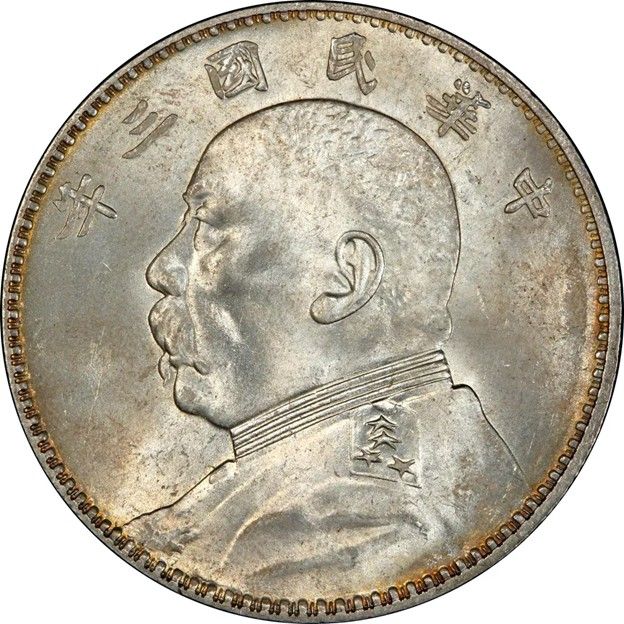
Image: Republic of China silver dollar with Yuan Shikai portrait.
Alt text: Chinese Republic “Fat Man dollar” from 1914-1921 showing Yuan Shikai left-facing portrait with Chinese characters and reeded edge, .890 silver.
Source: Numista
People’s Republic and Early Communist Era (1949 – 1980)
After 1949, the new government replaced precious metal coins with aluminum, copper-nickel, and brass issues. Designs emphasized socialist themes, such as workers, agriculture and industrial imagery, reflecting state ideology. Chinese commemorative coins in silver and copper-nickel celebrated political milestones like founding anniversaries and often celebrated revolutionary milestones. Most early People’s Republic circulation coins carry modest collector value, significant primarily as markers of China’s transition from precious metals to symbolic state coinage.
Reform and Bullion Revival (1980s – Present)
Economic liberalization in the 1980s reopened precious metal minting. China launched its Gold and Silver Panda series in 1982 and 1983 respectively, featuring .999 fine purity and annually changing panda designs, a departure from static Western bullion. Issued in multiple weights, Pandas merged national symbolism with modern engraving techniques, continuing China’s tradition of artistic coinage. Early issues from 1983 to 1985 – and particularly small-date and proof varieties – command strong premiums due to lower mintages. Counterfeits remain a persistent problem and collectors must verify authenticity through precise weight, diameter, and edge reeding.

Image: Modern Chinese Silver Panda bullion coin with bamboo background.
Source: Blanchard
Commemorative and Thematic Programs (1990s – Present)
Beyond Pandas, China produces limited-mintage gold commemoratives for historical events and anniversaries. The Lunar series, which consists of annual gold and silver coins honoring Chinese zodiac animals, has gained international popularity for its artistry and cultural resonance. Occasional bimetallic and platinum issues diversify the modern program. Chinese modern bullion, especially Pandas and early Chinese commemorative coins, typically carries higher numismatic premiums than generic bullion due to design changes and sustained collector demand.
Starting a Chinese Coin Collection in the Modern Era
The past two decades have transformed Chinese numismatics from a niche specialty into a major collecting category recognized in global auctions and investment portfolios. For new collectors, this modern era offers unprecedented access to both ancient Chinese coins and contemporary ones. Online resources, certification services, and active global markets make it possible to build a focused collection – whether centered on ancient cash coins, imperial silver, or modern Pandas – with greater confidence and accessibility than ever before
Global Market Growth
Chinese coins, particularly Silver Pandas and Lunar series issues, have gained strong traction among Western collectors over the past two decades. Rising awareness of Chinese culture, renewed interest in precious metals, and the aesthetic appeal of annually changing designs have driven sustained demand. Major Western auction houses now feature Chinese material regularly, and specialized dealer networks have emerged to serve this growing market.
Digital Authentication and Grading Standards
Technology has significantly improved verification and grading methods. Smartphone tools assist in comparing coins to reference images, while portable XRF analyzers verify metal composition on-site. Third-party grading services such as PCGS and NGC, both operating China-specific divisions, certify Chinese coins to international standards. Encapsulated (“slabbed”) examples often command premiums over raw pieces, especially for high-value issues where counterfeiting risk is greatest.
Buying and Selling Online
Chinese coins for sale are widely available through online platforms, but caution remains essential. Reputable dealers with clear return policies and authenticity guarantees provide the safest buying environment. Major auction platforms offer access to rare Chinese coins, though seller credentials should always be verified. Direct purchases from Chinese consumer sites carry higher risk: counterfeits are prevalent and buyer recourse limited. For selling, established dealers and auctions provide liquidity.
Roll Hunting and Circulation Finds
Outside China, discovering Chinese coins in circulation is uncommon but occasionally possible in areas with large Chinese communities. Most circulation finds are base-metal issues of modest value.
Identification and Authentication Guide
Authenticating Chinese coins requires understanding both historical production methods and modern counterfeiting techniques. The prevalence of high-quality fakes makes verification skills essential for any serious collector.
Character Recognition
Learning basic Chinese numerals and common reign marks forms the foundation of identification. Most cash coins display four characters read top-bottom-right-left, typically showing the emperor’s era name followed by tongbao (circulating treasure) or zhongbao (heavy treasure). Familiarizing yourself with frequently encountered dynasties, particularly Ming and Qing, allows quick preliminary assessment. Modern coins use simplified Chinese characters and Arabic numerals for dates and denominations.
Weight Standards
Authentic coins conform to specific weight ranges for their type and era. Cash coins varied by dynasty, but consistency within a series indicates genuineness. For early bronze issues, minor variation (often a few tenths of a gram) is normal, as exact uniformity was not achieved until machine striking. Modern Pandas and commemoratives must match published specifications exactly and even slight deviations suggest counterfeits.
Metal Composition
Testing silver and gold content verifies precious metal coins. Non-destructive methods include specific gravity tests, which compare weight-to-volume ratios against known standards. XRF analyzers provide precise composition readings without damaging coins. For old Chinese coins, particularly bronze pieces, patina color and texture offer clues: genuine bronze develops characteristic blue-green or brown oxidation.
Die Characteristics
Genuine Chinese coins show detail consistent with their minting method. Cast pieces exhibit subtle casting seams and granular texture, while struck coins display sharp rims and uniform fields. Counterfeits often reveal mismatched character styles, imprecise lettering, or incorrect edge patterns. Red flags include unusually low prices, artificial toning, and soft or uneven details inconsistent with authentic production.
Investment Perspective: Chinese Coins in 2025
Chinese coins occupy a unique position in the precious metals market, merging intrinsic metal value with numismatic rarity and deep cultural symbolism.
Advantages
Cultural Appeal
A growing Chinese and international collector base drives sustained demand, particularly for Pandas and Lunar series coins whose themes resonate across cultures. This interest is rooted in long-standing cultural attitudes toward gold as a store of wealth and a symbol of prosperity – values especially strong in China and India, which together account for nearly half of global gold demand. In both societies, gold plays a central role in savings, gifting, and intergenerational transfer. These traditions help explain why Chinese coins, especially gold and silver Pandas, maintain strong premiums even when global bullion prices soften.
Silver and Gold Content
Pandas offer precious-metal security yet command premiums over generic bullion due to annual design changes and limited mintages. For collectors evaluating silver investment options that include Chinese coins alongside other bullion products, Blanchard’s investment-grade silver selection provides a range of choices suited to different portfolio strategies.
Historical Significance
Ancient Chinese coins and imperial specimens, often bronze or silver, offer tangible connections to Chinese history, attracting collectors beyond traditional bullion investors.
Artistic Merit
The artistry of Chinese coinage attracts buyers who might not otherwise collect coins, broadening the market.
Limited Production
Annual design turnover creates natural scarcity, as each year’s Panda becomes a distinct collectible once the next design releases.
Considerations
Authenticity Concerns
High-quality counterfeits require expert verification or third-party grading before purchase.
Cultural Knowledge
Understanding Chinese history enhances collecting success, making Chinese coins more demanding than Western issues.
Import/Export Regulations
For ancient Chinese coins, regulations vary by jurisdiction and can complicate international transactions, particularly for items classified as cultural property. Exporting old Chinese coins itself is generally prohibited, and buyers should verify provenance and import requirements before making cross-border purchases.
Conclusion
Chinese coinage spans over two millennia of monetary evolution, from ancient cast bronze to modern struck bullion. For Western collectors, these coins offer a compelling combination of historical depth, artistic tradition, and investment potential that few other world coin series can match. The growing accessibility of authentication services, international grading standards, and specialized dealers has made building a Chinese collection more feasible than ever. Explore Blanchard’s Chinese Mint selection to begin or expand your collection with confidence.
FAQs
1. How much are Chinese coins worth?
Chinese coins’ value ranges from a few dollars for common late Qing cash coins to substantial sums for rare imperial silver or early-date Pandas. Condition, rarity, and authenticity determine price more than age alone.
2. Why do Chinese coins have holes?
The square hole allowed coins to be strung together on cords for counting, transport, and storage, a practical solution that became a defining feature of Chinese currency for over two thousand years.
3. How to identify ancient Chinese coins?
Read the four-character inscription top-bottom-right-left to determine the reign era and denomination, then compare calligraphic style, weight, and casting characteristics against reference materials for the suspected dynasty.
4. How to spot fake Chinese coins?
Check weight precision, examine character clarity and style consistency, look for incorrect casting seams or artificial patina on ancient Chinese coins, and verify edge reeding and specifications on modern issues. When in doubt, use third-party grading services.








